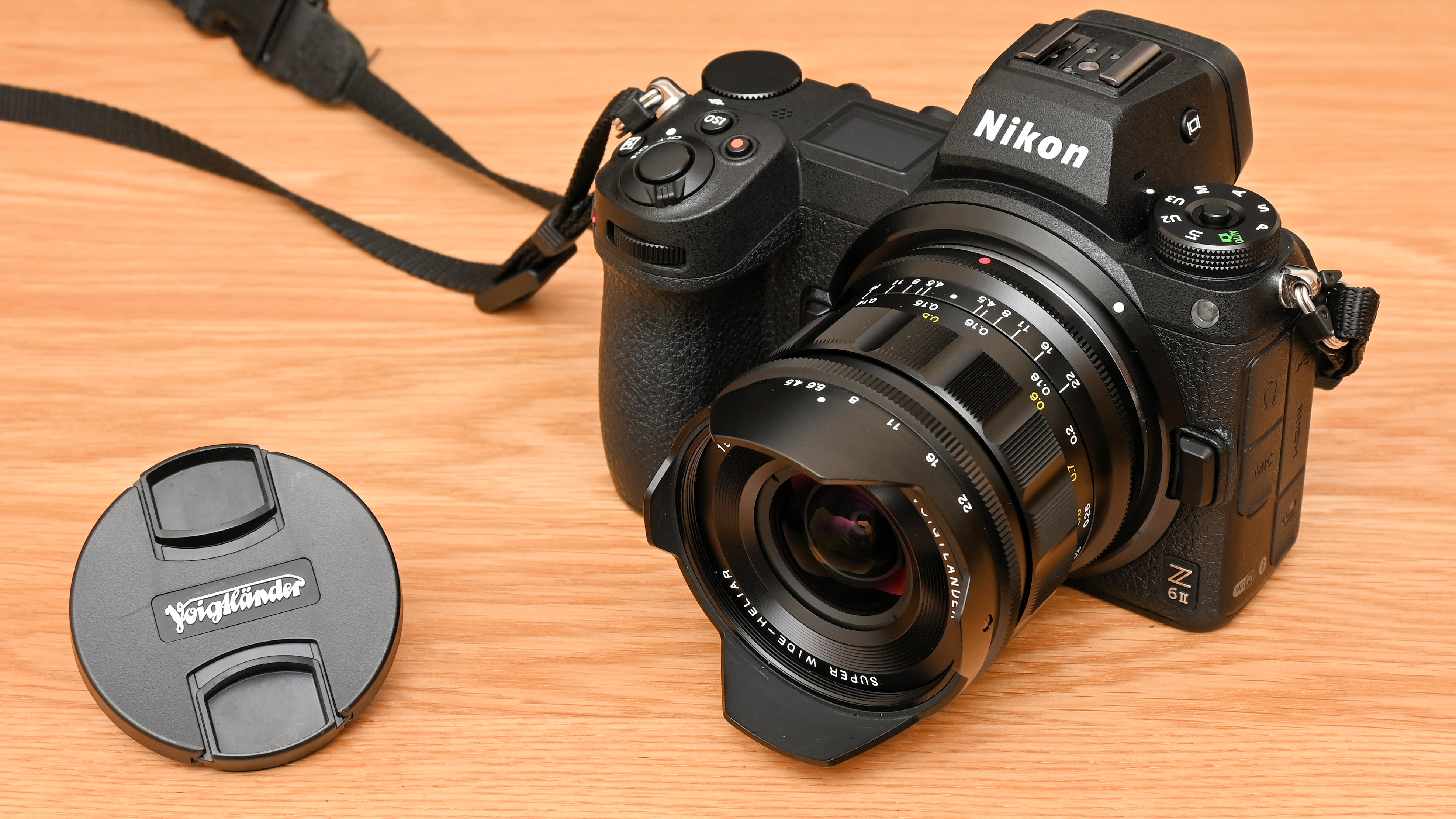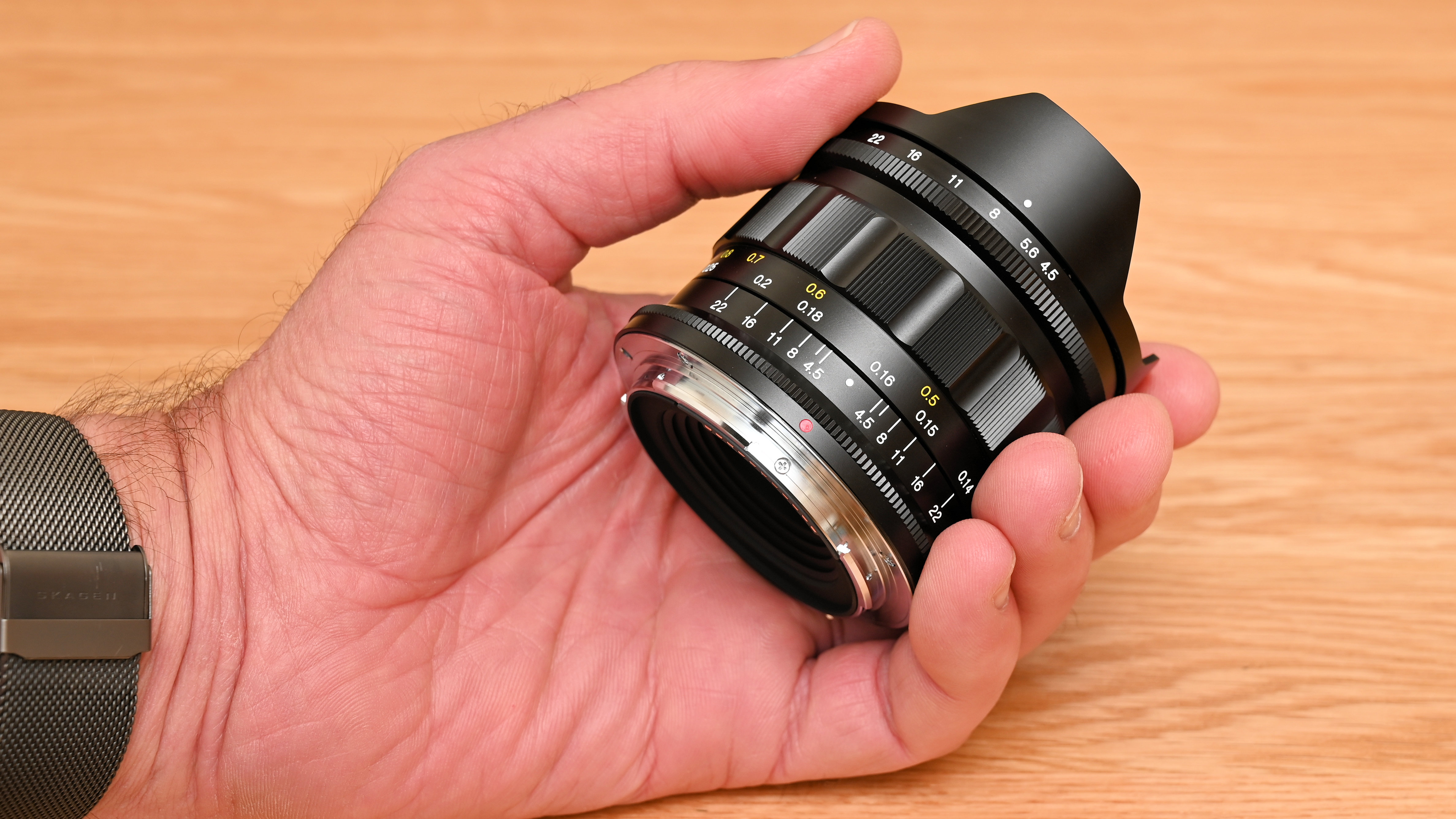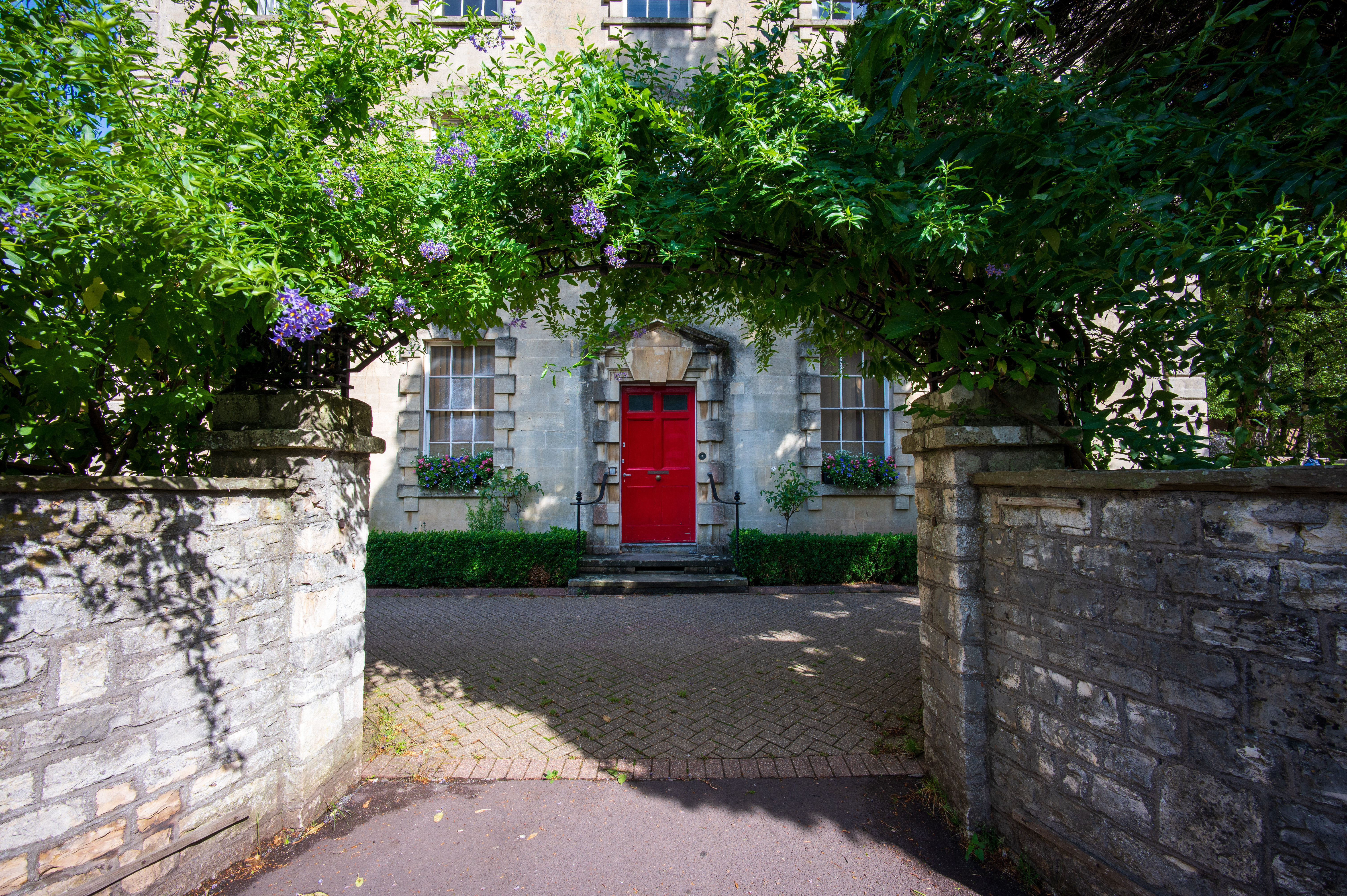Digital Camera World Verdict
Surely there’s some kind of optical wizardry going on here. If you’re accustomed to 14-24mm ultra-wide-angle zooms from the likes of Nikon and Sigma, you’ll know they’re big, chunky lenses. By contrast, this Voigtländer shoehorns an immense field of view into an unfeasibly small, lightweight package. Although it has electronic communication with Nikon Z system camera bodies, it’s a manual focus lens. That’s not really a problem, as the huge depth of field generally takes focusing out of the equation. It’s beautifully built and delivers excellent image quality, all at a highly competitive price.
Pros
- +
Compact and lightweight
- +
Lovely handling characteristics
- +
It’s a thing of retro beauty
Cons
- -
Manual focus and aperture control
- -
Hood isn’t easy to remove
- -
Not weather-sealed
Why you can trust Digital Camera World
The Voigtländer 15mm f/4.5 Super Wide-Heliar Z Aspherical is a new lens from a manufacturer that’s been around for as long as photography itself, kicking off with the legendary Petzval lens, versions of which resurfaced a few years ago backed by a crowdfunding project. The Voigtländer brand has been owned by Cosina since the turn of the century and this 15mm Super-Wide-Heliar for Nikon Z system cameras has a pretty long heritage itself, following in the footsteps of three generations of 15mm primes for Leica and Sony cameras.
Compared with the Nikon Z 14-24mm f/2.8 S, the Voigtländer is relatively tiny, less than half the weight and only a third of the price. Naturally, it doesn’t have such a bright aperture and lacks autofocus but the latter isn’t generally an issue. In our testing, we found that we could simply set the focus ring at infinity when shooting at f/8, and everything looked sharp from the far horizon right down to about a single meter away. The Voigtländer prime is also only about half the price the Nikon Z 14-30mm f/4 S zoom, which has a similar aperture rating and is again rather larger and heavier.
Specifications
Mount: Nikon Z (FX)
Full-frame: Yes
Autofocus: No
Stabilizer: No
Lens construction: 11 elements in 9 groups
Angle of view: 110 degrees
Diaphragm blades: 10
Minimum aperture: f/22
Minimum focusing distance: 0.126m
Maximum magnification ratio: 0.25x
Filter size: 58mm
Dimensions: 67x68mm
Weight: 290g
Key features
Heading the feature list is the ‘super wide’ field of view, delivered by the Voigtländer’s 15mm focal length. Indeed, you get a huge angle of view equating to 110 degrees on full-frame Nikon Z system cameras. You can also use the lens on Z DX (APS-C format) bodies and get a still fairly wide viewing angle but, in reality, it’s only a little wider than you’ll get from the dinky little Nikon Z DX 16-50mm f/3.5-6.3 VR. For our money, the Voigtländer is only really worth considering for Z FX (full-frame) cameras.
The expansive field of view is typically most useful for landscape photography and architectural interiors. With that in mind, as we’ve already mentioned, the lack of autofocus isn’t really a problem, due to the huge depth of field generated by the short focal length. Indeed, shooting at f/8, the hyperfocal distance is approximately 1m, at which everything will be rendered sharply from just 0.5m from the camera’s image sensor all the way to infinity. The lens is less than ideal for astrophotography, due to its modest f/4.5 aperture rating, in keeping with its compact build.
The lens can actually focus right down to 0.126m, or about 5 inches, again measured from the image sensor rather than the front of the lens. This enables extreme close-ups and also makes the lens useful for selfies and vlogging, if you want to set yourself in the scene by including a large area of background.
When accurate focusing is more critical in close-up shooting, the lens obliges with a focus distance scale and depth of field markings for apertures of f/4.5, 5.6, 8, 11, 16 and 22. In-camera focusing aids are also available, including color-change of the active focus point and focus peaking, both in the viewfinder and on the rear screen. Naturally, you can also use the magnified preview option when shooting with any Z system camera.
The updated Heliar optical design is based on 11 elements in 9 groups and features one aspherical element to boost sharpness and clarity while reducing aberrations. The aperture is controlled by a 10-blade diaphragm which remains well-rounded when stopping down.
Build and handling
The construction looks very vintage and feels like adding a bit of history to a Z system camera body. The lens feels solid and robust, with a metal casing, mounting plate and hood. As with many ultra-wide-angle lenses, the hood is fixed in place and helps to protect the front element. Unusually though, it can be removed as it’s held in place by two flat-head grub screws, and the lens does feature a 58mm filter attachment thread. However, removing and refitting the hood is more fiddly than when using a typical bayonet-fit or screw-in hood.
The best camera deals, reviews, product advice, and unmissable photography news, direct to your inbox!
If you’ve used Nikon lenses that feature an aperture ring, you’ll generally be used to being able to set and lock the ring at its narrowest setting and control the aperture from the camera body. Not only can this feel a little more intuitive, but it also enables shooting in Program AE and shutter-priority modes, instead of just in aperture-priority and metered manual modes. That’s not possible with the Voigtländer because, despite featuring electronic communication with the camera, the aperture can only be adjusted via the on-board control ring. And unlike a number of old-school Nikon lenses that have an aperture ring, it’s positioned at the front of the barrel instead of at the rear.
An upside of having the aperture control ring at the front is that we found it minimized the risk of altering the aperture accidentally during focusing. Manual focusing itself is a joy, thanks to the focus ring’s knurled and ridged profile, and its super-smooth action.
Ultimately, build quality and handling are excellent although, typical of Voigtländer lenses, the 15mm lacks any weather-seals.
Performance
The Voigtländer 15mm is a lens that truly punches well above its diminutive size and weight in terms of performance. Throughout our real-world testing, sharpness proved excellent from the center of the frame right out to the extreme edges and corners.
More surprisingly for such a tiny ultra-wide-angle lens, vignetting is none too severe even when shooting wide-open at f/4.5, and distortion is entirely negligible. The lack of noticeable distortion is actually pretty amazing considering that it’s based purely on optical prowess. That’s certainly not the case with many recent lenses designed for mirrorless cameras, which rely almost entirely on in-camera corrections. You can switch on automatic in-camera corrections for vignetting and distortion but they actually have no effect, as the lens doesn’t support these functions.
Color quality and contrast are impressive and there’s good resistance to ghosting and flare. The lens also delivers attractive sun stars although, as we’ve mentioned, the modest aperture rating is less than ideal for astrophotography.
Sample images
Lab results
We run a range of lab tests under controlled conditions, using the Imatest Master testing suite. Photos of test charts are taken across the range of apertures and zooms (where available), then analyzed for sharpness, distortion and chromatic aberrations.
We use Imatest SFR (spatial frequency response) charts and analysis software to plot lens resolution at the center of the image frame, corners and mid-point distances, across the range of aperture settings and, with zoom lenses, at four different focal lengths. The tests also measure distortion and color fringing (chromatic aberration).
Sharpness:
As always when lab-testing ultra-wide-angle lenses, regular sized test charts need to be shot from a very close distance. As a result in this case, center-sharpness looks very impressive but edge/corner-sharpness is relatively poor. In ‘real-world’ shooting at more typical focus distances, however, we found the lens delivered excellent sharpness right out to the extreme corners of the frame.
Fringing:
Color fringing scores are pretty mediocre towards the edges and corners of the image frame but, in practice, Nikon’s automatic in-camera correction for both JPEG and RAW files effectively takes any shortcomings out of the equation. You can see this for yourself in our example shots.
Distortion: -0.36
The distortion score is amazingly good for an ultra-wide-angle lens, again based on shooting a test chart at very close range. In real-world shooting, the lens behaves like an almost zero-distortion optic.
Verdict
Surely there’s some kind of optical wizardry going on here. If you’re accustomed to 14-24mm ultra-wide-angle zooms from the likes of Nikon and Sigma, you’ll know they’re big, chunky lenses. By contrast, this Voigtländer shoehorns an immense field of view into an unfeasibly small, lightweight package. Although it has electronic communication with Nikon Z system camera bodies, it’s a manual focus lens. That’s not really a problem, as the huge depth of field generally takes focusing out of the equation. It’s beautifully built and delivers excellent image quality, all at a highly competitive price.
Read more:
• Best camera lenses to get
• Best Canon lenses
• Best Nikon lenses
• Best Sony lenses
Matthew Richards is a photographer and journalist who has spent years using and reviewing all manner of photo gear. He is Digital Camera World's principal lens reviewer – and has tested more primes and zooms than most people have had hot dinners!
His expertise with equipment doesn’t end there, though. He is also an encyclopedia when it comes to all manner of cameras, camera holsters and bags, flashguns, tripods and heads, printers, papers and inks, and just about anything imaging-related.
In an earlier life he was a broadcast engineer at the BBC, as well as a former editor of PC Guide.
















